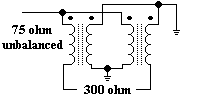What are baluns?
"A transmission line transformer for converting balanced
input to unbalanced output or vice versa. It may or may not provide wide frequency range impedance transformation depending upon the configuration used."
An old typical usage of the balun was (and still is) with TV antennas. The folded dipole is part of a yagi antenna which looks something like a pole with rods set across it at right angles. The second last one is folded into an oblong or rectangular shape. A folded dipole exhibits two important characteristics (a) its bandwidth is good for over an octave
(e.g. 50 Mhz to 100 Mhz or say 120 Mhz to 240 Mhz) AND its characteristic impedance is a more or less a constant 300 ohms.
In earlier days extensive use was made of 300 ohm twin lead ribbon cable to feed the signals to the TV receiver. BTW you can use just a length of 300 ohm ribbon cable to make a folded dipole.
When colour (or color if you prefer) TV was introduced the ribbon cable often created problems which could be rectified by the use of co-axial cable. This is not strictly correct because coax had earlier uses in TV because of other problems such as ghosting which became intolerable with the introduction of colour.
Now 300 ohm coax can be and is made. However 50 and 75 ohm cable is preferred for a variety of reasons. Our folded dipole also exhibits a "balanced" feed characteristic whilst coaxial cable has an "unbalanced" characteristic. Two problems. Each solved by the use of the balun.

Fig 1. - Schematic of a balun transformer
Perhaps we should have some clarification about this balanced versus unbalanced jazz. Mentally visualise it this way. If we have a plus 12V D.C. supply with ground return. That could be regarded for our illustrative purposes as the unbalanced 75 ohm input. On the other hand we could a symmetrical power supply referenced to ground which provides a + 12V D.C. AND a - 12V D.C. voltage. The only difference is we are dealing with RF which of course is very high A.C.
A practical 300 / 75 ohm balun could consist of four pieces of 0.4mm wire wound 2 1/2 turns through a balun core (look a bit like binoculars). In so doing we have achieved our two goals, (a) the impedance transformation and (b) gone from unbalanced to balanced.
A worthwhile publication on the topic of baluns
 ORDER - U.S.A. NOWBuilding and Using Baluns and Ununs : Practical Designs for the Experimenter - by Dr. Jerry Sevick, W2FMI.
ORDER - U.S.A. NOWBuilding and Using Baluns and Ununs : Practical Designs for the Experimenter - by Dr. Jerry Sevick, W2FMI.
Link to this page
NEW! - How to link directly to this page
Want to create a page link to me from your site? It couldn't be easier. No HTML knowledge required; even the technophobes can do it. All you need to do is copy and paste, the following code. All links are greatly appreciated; I sincerely thank you for your support.
Copy and paste the following code for a text link:
<a href="http://www.electronics-tutorials.com/basics/baluns.htm" target="_top">visit Ian Purdie VK2TIP's "Baluns" Page</a>
and it should appear like this:
visit Ian Purdie VK2TIP's "Baluns" Page

This site is hosted at WebWizards.Net for better value.
CARE TO BE A PRACTICAL SUPPORTER OF THIS SITE?
As you would imagine maintaining this site costs me considerable sums of money in many, many ways. If you believe this site is a valuable and FREE educational resource and, YOU want to keep it that way, then here's how YOU can demonstrate your very practical support for this site..
Thanks to these fine folks making voluntary donations, ensuring this site and our Newsletter remains FREE. Could YOU be listed here for your small contribution in return for your FREE education?. Our grateful thanks.


Please send me your valuable comments and suggestions! Tell your friends, tell a news group, tell your favourite magazine, heck tell the world!
Absolutely essential to keeping abreast of new and updated electronics tutorials is our comments or subscribe to our highly regarded FREE monthly newsletter form. Unsubscribe any time you like. You can view immediate past issues here to see if it is to your liking.
Related topics on Baluns
Antenna Basics.
subscribe to FREE monthly newsletter
join our "electronics discussion group"

YOU ARE HERE: HOME > BASICS > BALUNS
the author Ian C. Purdie, VK2TIP of www.electronics-tutorials.com asserts the moral right to
be identified as the author of this web site and all contents herein. Copyright © 2000, all rights reserved. See copying and links.
These electronic tutorials are provided for individual private use and the author assumes no liability whatsoever for the application, use, misuse, of any of these projects or electronics tutorials that may result in the direct or indirect damage or loss that comes from these projects or tutorials. All materials are provided for free private and public use.
Commercial use prohibited without prior written permission from www.electronics-tutorials.com.
Copyright © 2000 - 2001, all rights reserved. URL - www.electronics-tutorials.com/basics/baluns.htm
Updated 30th September, 2001
webmaster@electronics-tutorials.com
[END]


